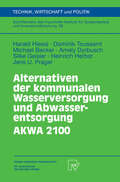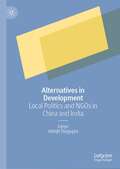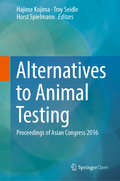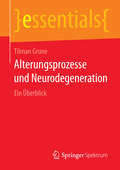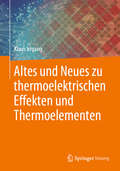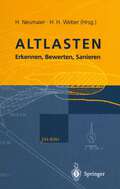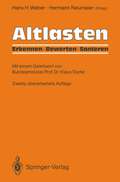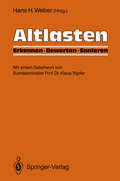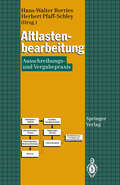- Table View
- List View
Alternative Wastewater Treatment: Low-Cost Small Systems, Research and Development Proceedings of the Conference held at Oslo, Norway, September 7–10, 1981 (Water Science and Technology Library #1)
by Arild Schanke Eikum and Robert W. SeabloomFollowing the end of World War II there was a major migra tion of population in the United States and Scandinavian countries to urban areas. As a result of this migration and in part due to the public works moratoria imposed during the war, a major pro gram of sewer construction was instigated, which resulted in the collection and subsequent concentration of large volumes of waste water at single discharge points. As the assimilative capacity of these receiving waters was exceeded, it led to or aggravated existing water pollution problems in these waters. To mitigate this degradation of water quality a massive program to construct wastewater treatment facilities was instigated. In addition, large amounts of money were spent on research to improve the technology of the conventional collection and treatment concept. In contrast, the wastewater disposal problem of the rural home owner received little attention, and in most cases the septic tank soil absorption system (ST-SAS) was the interim solution. In recent years there has been a fundamental change in the population growth pattern in the US and Scandinavian countries. It appears that a great many people are moving back to rural areas where they seem to prefer the suburban or small town envi ronment, yet at the same time want all the conveniences of urban life. The provision of proper wastewater disposal facilities presents a very perplexing problem, because the capital and operating costs of conventional sewers are usually financially impractical for rural areas.
Alternative Water Sources for Producing Potable Water: Advances in Research & Technology (The Handbook of Environmental Chemistry #124)
by Tamim Younos Juneseok Lee Tammy E. PareceThis book reviews alternative water sources for producing potable water, and offers a comprehensive overview of the latest research and technologies. Edited by experts at the forefront of water resource management, the book presents a paradigm shift in the quest for sustainable and efficient methods of producing potable water. The book commences with a perspective on the changing landscape in potable water production, setting the stage for a comprehensive analysis of cutting-edge techniques. Subsequent chapters offer a critical evaluation of potable rainwater harvesting system design and regulations and discuss the potential of utilizing urban runoff as a viable source for drinking water, highlighting both the possibilities and challenges that come with this approach. In this book, readers will also learn more about the sustainable reuse of wastewater, exploring innovative approaches on both building and city scales, and the complexities of producing potable water fromsaline waters. Particular attention is given to the latest advances in integrating renewable energy sources into the desalination process to produce potable water. In the final chapter of the book, readers will find an overview of the latest atmospheric water harvesting technologies, and an insightful discussion of the process, performance, energy efficiency, feasibility, and limitations of each. Given its breadth, this book is an important account for researchers, graduate-level students, and policymakers. It also serves as a roadmap for water resource engineers and planners tackling water scarcity and diverse water resources portfolios.
Alternative Worlds Imagined, 1500-1700: Essays on Radicalism, Utopianism and Reality (Palgrave Studies in Utopianism)
by James Colin DavisThis book address the relationship between utopian and radical thought, particularly in the early modern period, and puts forward alternatives approaches to imagined ‘realities’. Alternative Worlds Imagined, 1500-1700 explores the nature and meaning of radicalism in a traditional society; the necessity of fiction both in rejecting and constructing the status quo; and the circumstances in which radical and utopian fictions appear to become imperative. In particular, it closely examines non-violence in Gerrard Winstanley’s thought; millennialism and utopianism as mutual critiques; form and substance in early modern utopianism/radicalism; Thomas More’s utopian theatre of interests; and James Harrington and the political necessity of narrative fiction. This detailed analysis underpins observations about the longer term historical significance and meaning of both radicalism and utopianism.
Alternativen der Forschungs- und Entwicklungspolitik eines Unternehmens: Eine dynamische Computersimulation von Folgen der Unternehmensreaktion auf endogene und exogene Faktoren (Interdisciplinary Systems Research)
by GERBERICHAlternativen der kommunalen Wasserversorgung und Abwasserentsorgung AKWA 2100 (Technik, Wirtschaft und Politik #53)
by Harald Hiessl Dominik Toussaint Michael Becker Amely Dyrbusch Silke Geisler Heinrich Herbst Jens U. PragerAlternativen medizinischer Datenverarbeitung: Fachtagung, München-Großhadern, 19. Februar 1976 (Medizinische Informatik, Biometrie und Epidemiologie #2)
by Hans Konrad Selbmann K. Überla R. GreillerAlternativen zu Tierversuchen in Ausbildung, Qualitätskontrolle und Herz-Kreislauf-Forschung (Ersatz- und Ergänzungsmethoden zu Tierversuchen)
by Harald Schöffl H. Spielmann F. P. Gruber B. Koidl C. A. ReinhardtEin fächerübergreifendes Schwerpunktthema dieses Buches bilden die Fortschritte beim Einsatz von Ersatz- und Ergänzungsmethoden zu Tierversuchen in der Lehre und Ausbildung in den verschiedenen Disziplinen der biomedizinischen Wissenschaften. Anschließend stellen Vertreter der chemisch-pharmazeutischen Industrie Möglichkeiten des Ersatzes von Tierversuchen bei der Qualitätskontrolle von Arzneimitteln vor, dabei wurde erstmals als zukunftsweisender Aspekt die Verwendung von gentechnologisch veränderten Zellen anstelle von Ganztierversuchen herausgestellt. Einzelnen Unternehmen gelang es dabei für einige ihrer Produkte, den vollständigen Ersatz von behördlich vorgeschriebenen Tierversuchen durch tierversuchsfreie Methoden zu erreichen. Den Abschluß bilden Ersatz- und Ergänzungsmethoden in der Herz-Kreislaufforschung. "... Der Band setzt sich wissenschaftlich und erfreulich unpolemisch mit der Problematik Forschung und Tierversuche auseinander und kann Entscheidungsträgern in Wissenschaft, Forschung und Politik und allen an diesen Themen Interessierten zur Information über den derzeitigen Stand der Debatte dringend empfohlen werden." Ärztemagazin
Alternatives for Dermal Toxicity Testing
by Chantra Eskes Erwin Van Vliet Howard I. MaibachThis book provides comprehensive information on the alternative (non-animal) dermal toxicity test methods currently available for industrial, regulatory, and academic use and also explores potential future developments. It encompasses all areas of dermal toxicity, including skin irritation, skin corrosion, skin sensitization, UV-induced effects, and skin genotoxicity. An individual chapter is devoted to each test method, with coverage of the scientific basis, validation status and regulatory acceptance, applications and limitations, available protocols, and potential role within testing strategies. In addition, perspectives from the test developer are presented, for example regarding critical steps in the protocol. The closing section addresses areas that may be of relevance for the future of dermal toxicity safety testing, including the validation and regulatory acceptance of integrated testing strategies, novel complex skin models, and high-throughput screening techniques.
Alternatives in Development: Local Politics and NGOs in China and India
by Liyiyu Abhijit DasguptaThis book deals with the dynamics of local-level politics in China and India. China introduced new policies to restructure local politics in 1978. In place of communes, civil society organizations and cooperatives were introduced in villages. More changes came about with the introduction of the Organic Law of the Villagers' Committees of the People's Republic of China in 1998. The new local power structure includes state-sponsored institutions like Villagers Committees and the traditional civil society organizations (CSOs) and non-government organizations (NGOs). As in China, local politics in India undergoes considerable changes during the last few decades. Panchayati Raj Institutions (PRIs) were reformed in 1992 with a constitutional amendment act. CSOs and NGOs were allowed to function. Against this background, the present book is undertaken with the objectives first, to present two different models of local politics and second, to compare the two, finally to focus on the two different models of development. This book will interest scholars of rural governance, rural transformation, and the role of the grassroots CSOs and NGOs in shaping development program and growth in the two large countries in Asia.
Alternatives in Regulated River Management
by James A. GoreResearchers and managers of regulated river systems will find this volume useful in acquiring information for deciding an integrated management plan for regulated river operations. Rather than the ecological theory of impacts of flow regulation, emphasis has been placed on methods to predict water quality and habitat alterations, as well as techniques to mitigate impacts from various operational scenarios. Although most chapters refer to impacts of riverine impoundments, these alternatives apply to any regulated situation in which changes in water quality or flow pattern occur. The predictive modeling techniques are explained primarily from a theoretical background. However, extensive bibliographies can guide the uninitiated to specific texts and software. Where controversial techniques have been presented, alternate methods are also described. Major topic areas include water quality problems, channel modification and management, ecological modeling and management, as well as a section on perspectives for ecological management and special problems in developing nations.
Alternatives in Regulated River Management
by James A. GoreResearchers and managers of regulated river systems will find this volume useful in acquiring information for deciding an integrated management plan for regulated river operations. Rather than the ecological theory of impacts of flow regulation, emphasis has been placed on methods to predict water quality and habitat alterations, as well as techniques to mitigate impacts from various operational scenarios. Although most chapters refer to impacts of riverine impoundments, these alternatives apply to any regulated situation in which changes in water quality or flow pattern occur. The predictive modeling techniques are explained primarily from a theoretical background. However, extensive bibliographies can guide the uninitiated to specific texts and software. Where controversial techniques have been presented, alternate methods are also described. Major topic areas include water quality problems, channel modification and management, ecological modeling and management, as well as a section on perspectives for ecological management and special problems in developing nations.
Alternatives to Animal Testing: Proceedings of Asian Congress 2016
by Hajime Kojima Troy Seidle Horst SpielmannThis open access book presents recent advances in the pure sciences that are of significance in the quest for alternatives to the use of animals in research and describes a variety of practical applications of the three key guiding principles for the more ethical use of animals in experiments – replacement, reduction, and refinement, collectively known as the 3Rs. Important examples from across the world of implementation of the 3Rs in the testing of cosmetics, chemicals, pesticides, and biologics, including vaccines, are described, with additional information on relevant regulations. The coverage also encompasses emerging approaches to alternative tests and the 3Rs. The book is based on the most informative contributions delivered at the Asian Congress 2016 on Alternatives and Animal Use in the Life Sciences. It will be of value for those working in R&D, for graduate students, and for educators in various fields, including the pharmaceutical and cosmetic sciences, pharmacology, toxicology, and animal welfare. The free, open access distribution of Alternatives to Animal Testing is enabled by the Creative Commons Attribution license in International version 4: CC BY 4.0.
Alternatives to Animal Testing: New Ways in the Biomedical Sciences, Trends and Progress
by Christoph A. ReinhardtOpinion leaders in science and politics examine findings and legislation in alternatives to animal testing! Refine, reduce, replace - These are the three demands that scientists have placed upon themselves in their search for alternatives to animal testing. Indeed much interdisciplinary research is being carried on today, and new fields have emerged, such as in-vitro toxicology. The three R's call for new scientific insights. Moreover, validation and acceptance strategies have to be adapted, a process of much ongoing interest and vital concern to the pharmaceutical and cosmetic industries. Researchers need to know exactly what has been achieved and accepted in alternatives to animal testing in science and politics. In this book they have the opportunity to benefit from the knowledge and expertise of leading researchers and influential representatives of national and international regulatory authorities.
Alternatives to Antibiotics: Recent Trends and Future Prospects
by Tilak Saha Manab Deb Adhikari Bipransh Kumar TiwaryThis book discusses prospective alternative approaches to fight bacterial infections to minimize the indiscriminate use of conventional antibiotics. It offers the current knowledge on research and development of alternative antibacterial agents such as probiotics, nanobiotics etc. while it also discusses newly emerging trends such as phage therapy, antibody therapy etc. The book highlights on the phytochemicals with potent antibacterial activities as alternatives to conventional antibiotics. Chemical modification to develop next generation antibiotics with enhanced efficacy has also been included. Such modifications are reported to overcome the inherent resistance of the parent antibiotics. Phage therapy and targeted antibodies are considered as potential alternative approaches to treat bacterial ailments and represent areas of cutting-edge research and have therefore been discussed with sufficient care. Mainly, the book highlights various approaches other than conventional antibiotics in treating bacterial infections. The scientific advancements in these areas will strengthen the ‘One Health’ approach benefiting human beings, animals and environment as well. This book is a comprehensive resource to cater researchers, biological scientists, herbalists and clinical practitioners with up-to-date information on antibacterials other than antibiotics.
Alternatives to Pesticides in Stored-Product IPM
by Bhadriraju Subramanyam David W. HagstrumInsects associated with raw grain and processed food cause qualitative and quantitative losses. Preventing these losses caused by stored-product insects is essential from the farmer's field to the consumer's table. While traditional pesticides play a significant role in stored-product integrated pest management (IPM), there has recently been, and will continue to be, a greater emphasis on alternative approaches. Alternatives to Pesticides in Stored-Product IPM details the most promising methods, ranging from extreme temperatures to the controversial radiation, and from insect-resistant packaging to pathogens. This collection is essential for anyone in academia, industry, or government interested in pest ecology or food or grain science.
Alterungsprozesse und Neurodegeneration: Ein Überblick (essentials)
by Tilman GruneDas Essential behandelt in leicht verständlicher, komprimierter Weise die Grundlagen altersbedingter Zellveränderungen, die unter Umständen zur Neurodegeneration führen können. Der Autor erläutert, wie der Alterungsprozess und die Neurodegeneration durch oxidativen Stress und dabei entstehende Schäden beeinflusst werden. Unter diesen Schäden nimmt die Bildung von Proteinaggregaten, die hier besonders ausführlich beschrieben werden, eine Schlüsselstellung ein. Darüber hinaus werden einige Aspekte der Ernährung im Alter und ihre möglichen Auswirkungen auf die Entstehung von neurodegenerativen Erkrankungen vorgestellt.
Altes und Neues über die Tuberkulose: Fortbildungsvortrag gehalten vor rheinhessischen Ärzten 1920 (Bibliothek von Coler-von Schjerning)
by Georg B. GruberDieser Buchtitel ist Teil des Digitalisierungsprojekts Springer Book Archives mit Publikationen, die seit den Anfängen des Verlags von 1842 erschienen sind. Der Verlag stellt mit diesem Archiv Quellen für die historische wie auch die disziplingeschichtliche Forschung zur Verfügung, die jeweils im historischen Kontext betrachtet werden müssen. Dieser Titel erschien in der Zeit vor 1945 und wird daher in seiner zeittypischen politisch-ideologischen Ausrichtung vom Verlag nicht beworben.
Altes und Neues über konvexe Körper (Elemente der Mathematik vom höheren Standpunkt aus #3)
by H. HadwigerAltes und Neues zu thermoelektrischen Effekten und Thermoelementen
by Klaus IrrgangDas Buch ist geschrieben von einem Praktiker mit über 25jähriger Erfahrung auf diesem Gebiet. Die technischen Verfahren und Anwendungen, die in diesem Buch angesprochen werden, sind für viele junge Ingenieure und angewandte Physiker von großem Interesse. In diesem Werk sind aber auch einige der theoretischen Grundlagen erweitert bzw. erstmals eingebracht worden, so z.B. die theoretischen Seebeckkoeffizienten von Übergangsmetallen und Übergangslegierungen sowie der Einfluß der thermischen Ausdehnung auf die Seebeckkoeffizienten.Insgesamt stellt das Buch gegenüber älteren Standardwerken zur Thermoelektrizität ein willkommenes Standardwerk auf neuestem Stand der Technik und der Theorie metallischer Thermomaterialien dar.
Altes und Neues zu thermoelektrischen Effekten und Thermoelementen
by Klaus IrrgangDieses Buch, geschrieben von einem Praktiker mit über 25jähriger Erfahrung auf diesem Gebiet, ist ein Standardwerk auf dem neuesten Stand der Technik zur Thermoelektrizität sowie zur Theorie metallischer Thermomaterialen. Die dargestellten technischen Verfahren und Anwendungen sind für junge Ingenieure und angewandte Physiker von großem Interesse. Theoretische Grundlagen werden erweitert bzw. erstmals eingebracht, so z.B. die theoretischen Seebeckkoeffizienten von Übergangsmetallen und Übergangslegierungen sowie der Einfluss der thermischen Ausdehnung auf die Seebeckkoeffizienten.Diese 2. Auflage enthält, neben erheblichen Überarbeitungen und Erweiterungen, die neueren Erkenntnisse der Wissenschaft und der gerätetechnischen Weiterentwicklungen auf dem Gebiet der Temperaturmesstechnik, einschließlich der Fachthemen Drift und Selbstüberwachung.
Altlasten: Erkennen, Bewerten, Sanieren
by W. Fresenius G. Mattheß H. Müller-Kirchenbauer W. D. Sondermann K. Storp E. WeßlingEin in Wissenschaft und Praxis der Sanierung von Altlasten erfahrenes Herausgeber- und Autorenteam gibt in diesem Standardwerk einen umfassenden Überblick über die Sanierungstechnologien. Die kritische Darstellung orientiert sich am Stand der Technik und am ökonomisch Machbaren. Alle Beiträge wurden für die dritte Auflage komplett überarbeitet, aktuelle Themen neu aufgenommen.
Altlasten: Erkennen, Bewerten, Sanieren
by W. Fresenius G. Mattheß H. Müller-Kirchenbauer K. Storp E. WeßlingBoden-, Luft- und Grundwasserverunreinigungen durch gesundheitsgefährdende Abfallstoffe z.B. durch Ablagerung auf industriell genutzten Flächen und auf Deponien oder durch Lekkagen von Tanklagern, Rohrleitungen oder Abwasserkanälen sind in vielen industrialisierten Ländern zu einem ernsten Problem geworden. Ein in Wissenschaft und Praxis der Sanierung von Altlasten, z.B. Deponien, Altablagerungen, alte Industriestandorte, erfahrenes Herausgeber- und Autorenteam gibt einen am Stand der Technik und am ökonomisch Machbaren orientierten und kritisch bewerteten Überblick über die Sanierungstechnologien. Für Industriebetriebe jeder Branche, für Zulassungs- und Gewerbeaufsichtsämter, Behörden für Abfall, Abwasser, Umweltschutz oder Altlastensanierung in Bund, Ländern und Gemeinden, für Unternehmen der Sanierungs-, Tiefbau- und Geotechnik, für Politiker, Unternehmer und Verwaltungsspitzen ist das Werk ein wertvoller Ratgeber. Für die zweite Auflage wurden alle Beiträge dem aktuellen Stand angepaßt; einige Beiträge sind komplett überarbeitet worden.
Altlasten: Erkennen, Bewerten, Sanieren
by Wilhelm Fresenius Georg Matthess Hanno Müller-Kirchenbauer Klaus Storp Erwin WeßlingBoden-, Luft- und Grundwasserverunreinigungen durch gesundheitsgefährdende Abfallstoffe, z. B. durch Ablagerung auf industriell genutzten Flächen und auf Deponien oder durch Leckagen von Tanklagern, Rohrleitungen oder Abwasserkanälen sind in vielen industrialisierten Ländern zu einem ernsten Problem geworden. Ein in Wissenschaft und Praxis der Sanierung von Altlasten erfahrenes Herausgeber- und Autorenteam gibt einen am Stand der Technik und am ökonomisch Machbaren orientierten und kritisch bewerteten Überblick über die Sanierungstechnologien. Für Industriebetriebe jeder Branche, für Zulassungs- und Gewerbeaufsichtsämter, Behörden für Abfall, Abwasser, Umweltschutz oder Altlastensanierung in Bund, Ländern und Gemeinden, für Unternehmen der Sanierungs-, Tiefbau- und Geotechnik, für Politiker, Unternehmer und Verwaltungsspitzen ist das Werk ein wertvoller Ratgeber. Aus dem Inhalt: Rechtliche Fragen und Öffentlichkeit.- Erfassen und Bewerten.- Sanierungsverfahren.- Überwachung.




